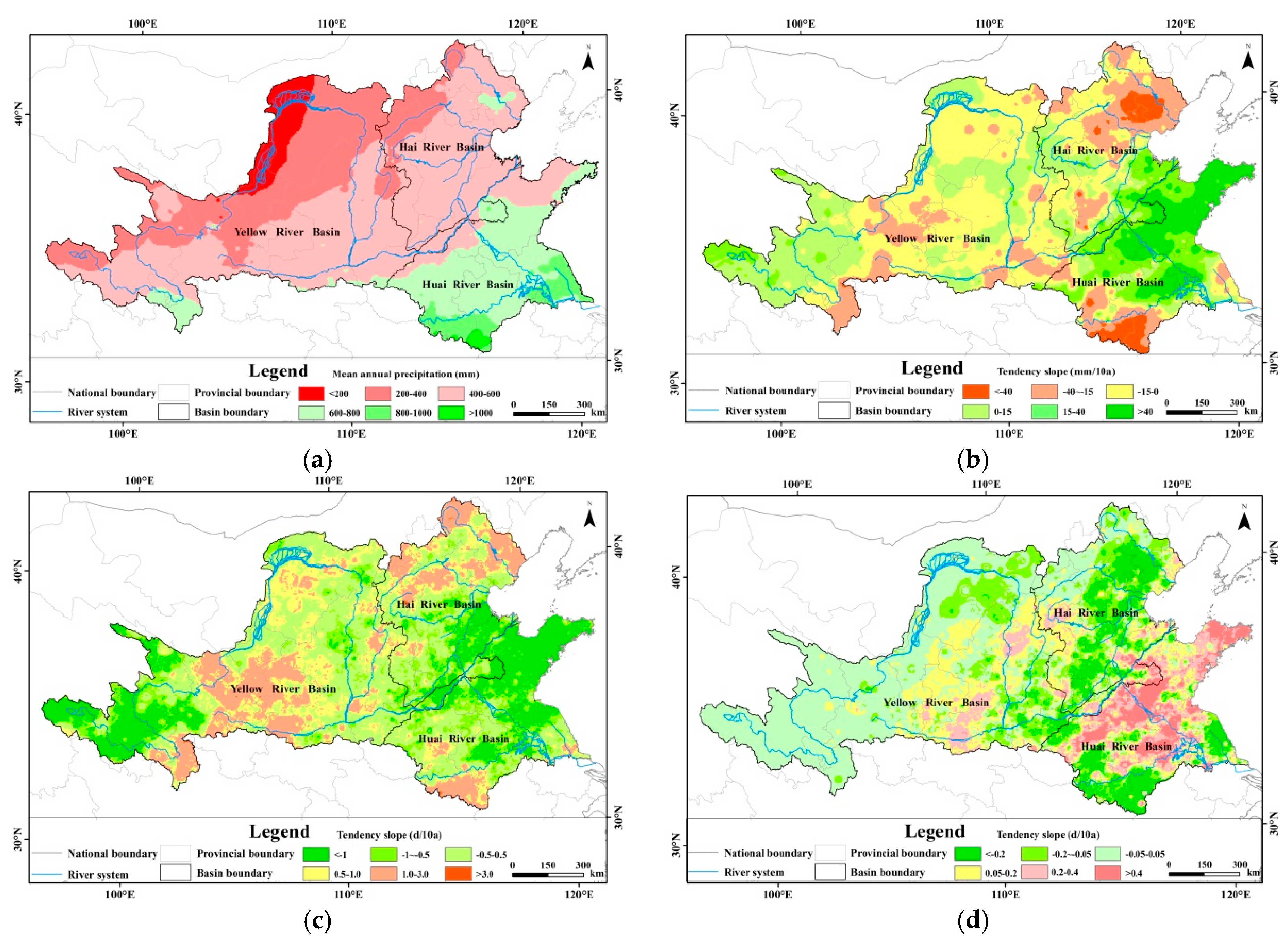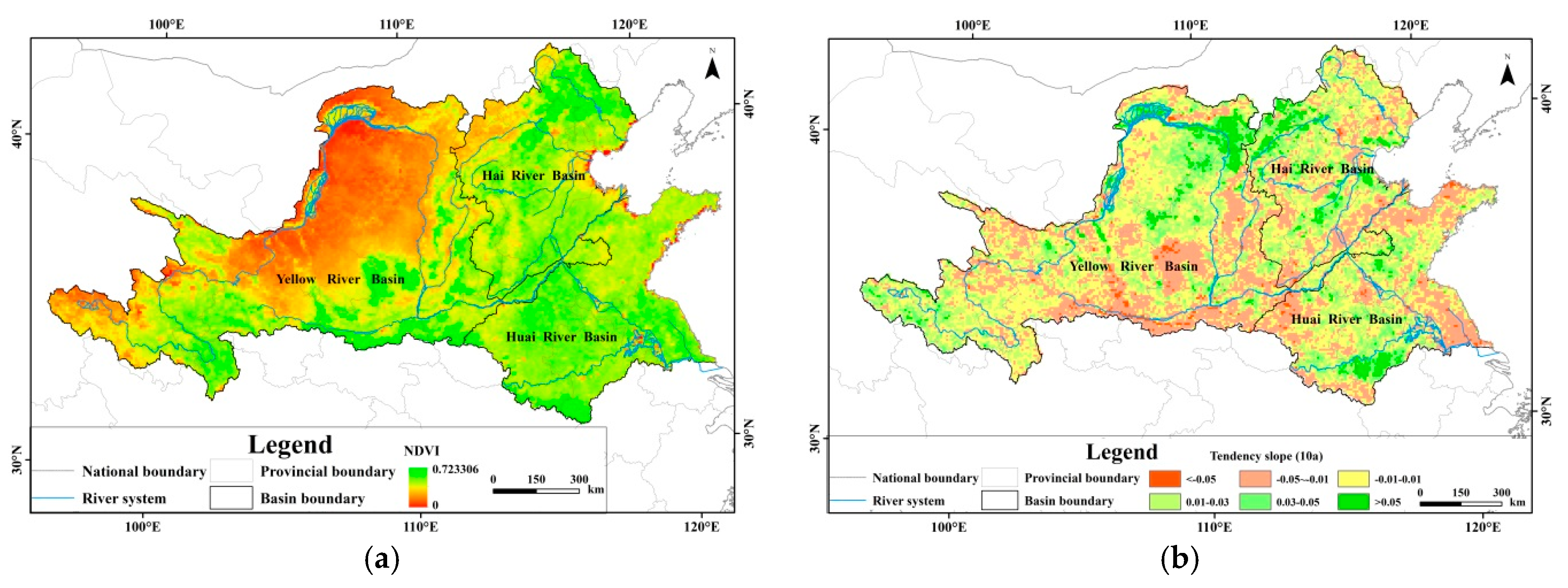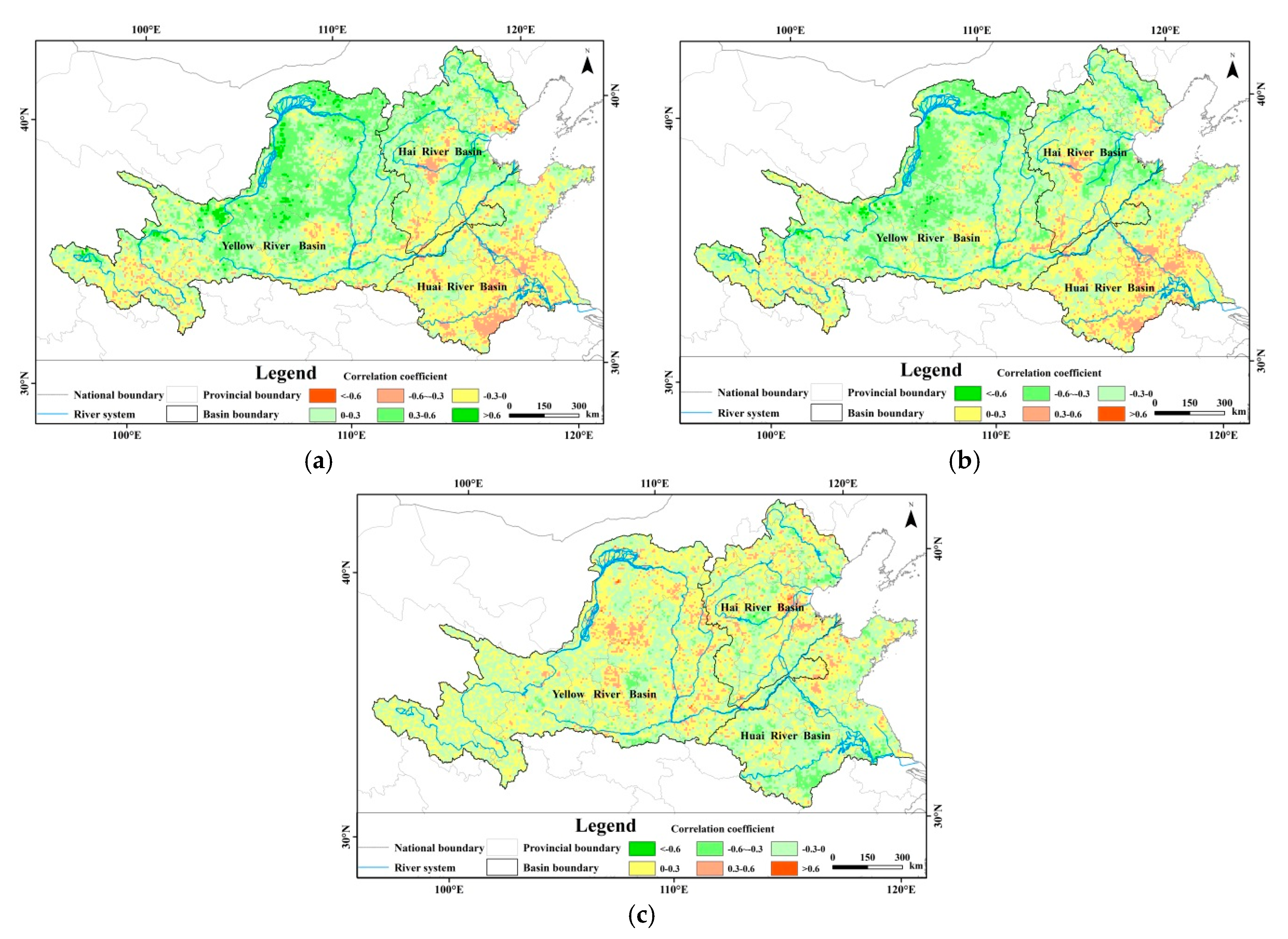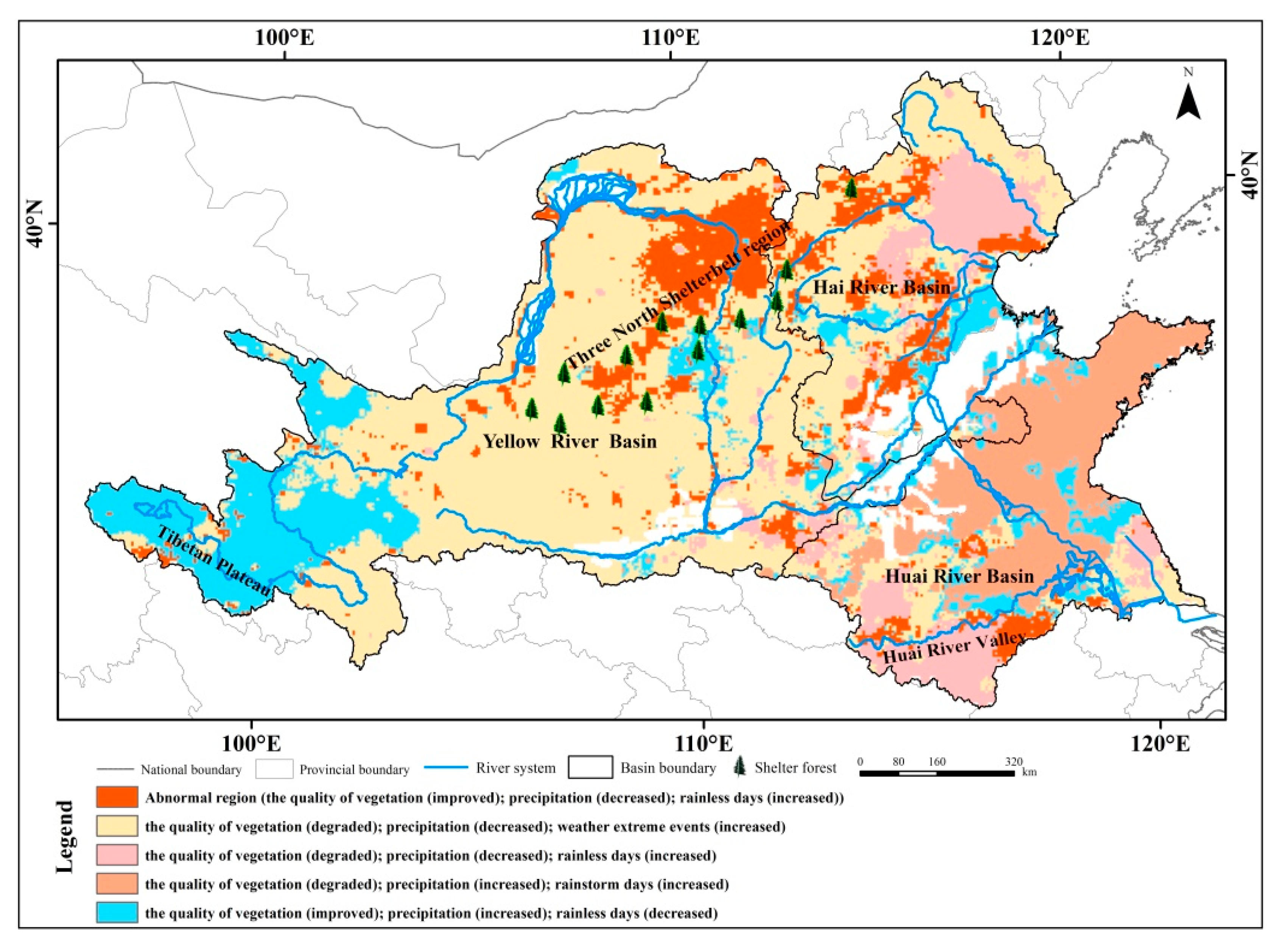Regional Correlation between Precipitation and Vegetation in the Huang-Huai-Hai River Basin, China
Abstract
1. Introduction
2. Materials and Methods
2.1. Study Site
2.2. Data Sources and Processing
2.3. Time Series Analysis
2.4. Spatial Clustering Analysis
3. Results and Discussion
3.1. Spatio-Temporal Patterns of Precipitation
3.1.1. Spatial Patterns of Precipitation
3.1.2. Spatio-Temporal Variations of Precipitation
3.1.3. Spatio-Temporal Variations of Precipitation Anomalies
3.2. Spatio-Temporal Patterns of Vegetation Coverage
3.2.1. Spatial Patterns of NDVI
3.2.2. Spatio-Temporal Variations of Vegetation Coverage
3.3. Correlation of Vegetation Coverage and Precipitation
3.3.1. The Relationship between Vegetation Coverage and Precipitation
3.3.2. The Relationship between Vegetation Coverage and Precipitation Anomalies
3.4. Multi-Factor Cluster Analysis
4. Conclusions
Acknowledgments
Author Contributions
Conflicts of Interest
References
- Cramer, W.P.; Leemans, R. Assessing Impacts of Climate Change on Vegetation Using Climate Classification Systems in Vegetation Dynamics & Global Change; Springer: New York, NY, USA, 1993; pp. 190–217. [Google Scholar]
- Myneni, R.B.; Keeling, C.D.; Tucker, C.J.; Asrar, G.; Nemani, R.R. Increased Plant Growth in the Northern High Latitudes from 1981 to 1991. Nature 1997, 386, 698–702. [Google Scholar] [CrossRef]
- Liu, Z.; Feng, M.; Zhou, W.; Li, Q. Research the dynamics of landscape spatial pattern of urban-rural ecotone using multi-temporal remote sensing image. IEEE Geosci. Remote Sens. Symp. 2009, 5, 264–267. [Google Scholar]
- Karlson, M.; Ostwald, M. Remote sensing of vegetation in the Sudano-Sahelian zone: A literature review from 1975 to 2014. J. Arid Environ. 2016, 124, 257–269. [Google Scholar] [CrossRef]
- Feng, T.; Martin, B.; Liu, Y.Y.; Aleixandre, V.; Torbern, T.; Abdoul, A.D.; Kjeld, R.; Cheikh, M.; Wang, Y.J.; Rasmus, F. Remote sensing of vegetation dynamics in drylands: Evaluating vegetation optical depth (VOD) using AVHRR NDVI and in situ, green biomass data over West African Sahel. Remote Sens. Environ. 2016, 177, 265–276. [Google Scholar]
- Slayback, D.A.; Pinzon, J.E.; Los, S.O.; Tucker, C.J. Northern hemisphere photosynthetic trends 1982–1999. Glob. Chang. Biol. 2013, 9, 1–15. [Google Scholar] [CrossRef]
- Alcaraz-Segura, D.; Liras, E.; Tabik, S.; Paruelo, J.; Cabello, J. Evaluating the consistency of the 1982–1999 NDVI trends in the Iberian Peninsula across four time-series derived from the AVHRR sensor: LTDR, GIMMS, FASIR, and PAL-II. Sensors 2010, 10, 1291–1314. [Google Scholar] [CrossRef] [PubMed]
- Beck, P.S.A.; Goetz, S.J. Satellite observations of high northern latitude vegetation productivity changes between 1982 and 2008: Ecological variability and regional differences. Environ. Res. Lett. 2011, 6, 5501–5511. [Google Scholar] [CrossRef]
- Gonsamo, A.; Chen, J.M. Circumpolar vegetation dynamics product for global change study. Remote Sens. Environ. 2016, 182, 13–26. [Google Scholar] [CrossRef]
- Gao, Q.Z.; Guo, Y.Q.; Xu, H.M.; Hasbagen, G.; Li, Y.; Wan, Y.F.; Qin, X.B.; Ma, X.; Liu, S. Climate change and its impacts on vegetation distribution and net primary productivity of the alpine ecosystem in the Qinghai-Tibetan Plateau. Sci. Total Environ. 2016, 554–555, 34–41. [Google Scholar] [CrossRef] [PubMed]
- Rodrigues, J.M.; Behling, H.; Giesecke, T. Holocene dynamics of vegetation change in southern and southeastern Brazil is consistent with climate forcing. Quat. Sci. Rev. 2016, 146, 54–65. [Google Scholar] [CrossRef]
- Intergovernmental Panel on Climate Change(IPCC). Climate Change 2007. In The Physical Science Basis; Cambridge University Press: Cambridge, UK, 2007. [Google Scholar]
- Benhadj, I.; Simonneaux, V.; Mougenot, B.; Khabba, S.; Chehbouni, A. Land Use and Crop Evapotranspiration in Tensift/Marrakech Plain: Inter-Annual Analysis Based on MODIS Satellite Data. In Proceedings of the 13th IWRA World Water Congress, Montpellier, France, 1–4 September 2008; pp. 1–15. [Google Scholar]
- Spano, D.; Cesaraccio, C.; Duce, P.; Snyder, R.L. Phenological stages of natural species and their use as climate indicators. Int. Biometeorol. 1999, 42, 124–133. [Google Scholar] [CrossRef]
- Li, J.; Lewis, J.; Rowland, J.; Tappan, G.; Tieszen, L.L. Evaluation of land performance in Senegal using multi-temporal NDVI and rainfall series. J. Arid Environ. 2004, 59, 463–480. [Google Scholar] [CrossRef]
- Wessels, K.J.; Prince, S.D.; Malherbe, J.; Smallc, J.; Frostd, P.E.; van Zyl, D. Can human-induced land degradation be distinguished from the effects of rainfall variability? A case study in South Africa. J. Arid Environ. 2007, 68, 271–297. [Google Scholar]
- Li, A.; Wu, J.; Huang, J. Distinguishing between human-induced and climate-driven vegetation changes: A critical application of RESTREND in inner Mongolia. Landsc. Ecol. 2012, 27, 969–982. [Google Scholar] [CrossRef]
- Buyantuyev, A.; Wu, J. Urbanization alters spatiotemporal patterns of ecosystem primary production: A case study of the Phoenix metropolitan region USA. J. Arid Environ. 2009, 73, 512–520. [Google Scholar] [CrossRef]
- Gessner, U.; Naeimi, V.; Klein, I.; Kuenzer, C.; Klein, D.; Dech, S. The relationship between precipitation anomalies and satellite-derived vegetation activity in Central Asia. Glob. Planet. Chang. 2012, 110, 74–87. [Google Scholar] [CrossRef]
- Fu, B.J.; Liu, Y.; Lv, Y.; He, C.S.; Zeng, Y.; Wu, B.F. Assessing the soil erosion control service of ecosystems change in the Loess Plateau of China. Ecol. Complex. 2011, 8, 284–293. [Google Scholar] [CrossRef]
- Liu, Q.; Yang, Z.; Cui, B. Spatial and temporal variability of annual precipitation during 1961–2006 in Yellow River Basin, China. J. Hydrol. 2008, 361, 330–338. [Google Scholar] [CrossRef]
- Wang, W.; Shao, Q.X.; Peng, S.Z.; Zhang, Z.X.; Xing, W.Q.; An, G.Y.; Yong, B. Spatial and temporal characteristics of changes in precipitation during 1957–2007 in the Haihe River basin, China. Stoch. Environ. Res. Risk Assess. 2011, 25, 881–895. [Google Scholar] [CrossRef]
- Sun, R.; Liu, C.M.; Zhu, Q.J. Relationship between fractional vegetation cover change and rainfall in the Yellow River Basin. Acta Geogr. Sci. 2001, 56, 667–672. (In Chinese) [Google Scholar]
- Jing, X.; Yao, W.Q.; Wang, J.H.; Song, X.Y. A study on the relationship between dynamic change of vegetation coverage and precipitation in Beijing’s mountainous areas during the last 20 years. Math. Comput. Model. 2011, 54, 1079–1085. [Google Scholar] [CrossRef]
- Zhao, A.Z.; Liu, X.F.; Zhu, X.F.; Pan, Y.Z.; Chen, Y.C. Spatiotemporal analyses and associated driving forces of vegetation coverage change in the Loess Plateau. Chin. Environ. Sci. 2016, 36, 1568–1578. (In Chinese) [Google Scholar]
- Pang, G.; Wang, X.; Yang, M. Using the NDVI to identify variations in, and responses of, vegetation to climate change on the Tibetan Plateau from 1982 to 2012. Quat. Int. 2016, 1–10. [Google Scholar] [CrossRef]
- Yin, J.; Yan, D.H.; Yang, Z.Y.; Yuan, Z.; Zhang, C. Projection of extreme precipitation in the context of climate change in Huang-Huai-Hai region, China. J. Earth Syst. Sci. 2016, 125, 1–13. [Google Scholar] [CrossRef]
- Yan, D.H.; Wu, D.; Huang, R.; Wang, L.N.; Yang, G.Y. Drought evolution characteristics and precipitation intensity changes during alternating dry-wet changes in the Huang-Huai-Hai River basin. Hydrol. Earth Syst. Sci. 2013, 17, 2859–2871. [Google Scholar] [CrossRef]
- Guo, J.; Ren, G.Y. Recent change of pan evaporation and possible climate factors over the Huang-Huai-Hai watershed, China. Adv. Water Sci. 2005, 16, 666–672. (In Chinese) [Google Scholar]
- Zhang, D.D.; Yan, D.H.; Wang, Y.C.; Lu, F.; Wu, D. Changes in extreme precipitation in the Huang-Huai-Hai River basin of China during 1960–2010. Theor. Appl. Climatol. 2015, 120, 195–209. [Google Scholar] [CrossRef]
- Wang, G.Q.; Zhang, J.Y. Variation of water resources in the Huang-Huai-Hai areas and adaptive strategies to climate change. Quat. Int. 2015, 380–381, 180–186. [Google Scholar] [CrossRef]
- Shao, W.W.; Huang, H.; Wang, J.H.; Cao, L. Analysis on the development state and problems of the water resources in the basins of Yellow River, Huaihe River and Haihe River. J. Chin. Inst. Water Resour. Hydropower Res. 2012, 10, 1–9. (In Chinese) [Google Scholar]
- Zhao, J. The Responses to Drought and Dought-Resistant Characteristics of Nature Vegetation in Huang-Huai-Hai River Basin. Master’s Thesis, Donghua University, Shanghai, China, 2015; p. 25p. (In Chinese). [Google Scholar]
- Available online: http://www.nasa.gov/ (accessed on 6 July 2013).
- Fensholt, R.; Proud, S.R. Evaluation of earth observation based global long term vegetation trends-comparing GIMMS and MODIS global NDVI time series. Remote Sens. Environ. 2012, 119, 131–147. [Google Scholar] [CrossRef]
- Jong, R.D.; Bruin, S.D.; Schaepman, M.; Dent, D. Quantitative mapping of global land degradation using earth observations. Int. J. Remote Sens. 2011, 32, 6823–6853. [Google Scholar] [CrossRef]
- Mao, D.H.; Wang, Z.M.; Luo, L.; Ren, C.Y. Integrating AVHRR and MODIS data to monitor NDVI changes and their relationships with climatic parameters in Northeast China. Int. J. Appl. Earth Obs. Geoinf. 2012, 18, 528–536. [Google Scholar] [CrossRef]
- Han, X.Z.; Li, S.M.; Zhu, X.X.; Luo, J.N. China vegetation time-space change research in 20 years. In Proceedings of the China Meteorological Society Annual Conference, Chengdu, China, 25–27 October 2006; pp. 753–759. [Google Scholar]
- Omotosho, J.B. Long-range prediction of the onset and end of the rainy season in the west African Sahel. Int. J. Climatol. 1992, 12, 369–382. [Google Scholar] [CrossRef]
- Prince, S.D.; Colstoun, E.B.D.; Kravitz, L.L. Evidence from rain-use efficiencies does not indicate extensive sahelian desertification. Glob. Chang. Biol. 1998, 4, 359–374. [Google Scholar] [CrossRef]
- Wang, J.; Price, K.P.; Rich, P.M. Spatial patterns of NDVI in response to precipitation and temperature in the central Great Plains. Int. J. Remote Sens. 2001, 22, 3827–3844. [Google Scholar] [CrossRef]
- Qi, J.; Marsett, R.C.; Moran, M.S.; Goodrich, D.C.; Heilman, P.; Kerr, Y.H.; Dedieu, G.; Chehbouni, A.; Zhang, X.X. Spatial and temporal dynamics of vegetation in the San Pedro River basin area. Agric. For. Meteorol. 2000, 105, 55–68. [Google Scholar] [CrossRef]
- Available online: http://cdc.cma.gov.cn/ (accessed on 1 June 2013).
- Garcia, M.; Peters-Lidard, C.D.; Goodrich, D.C. Spatial interpolation of precipitation in a dense gauge network for monsoon storm events in the southwestern United States. Water Resour. Res. 2008, 44, 5–13. [Google Scholar] [CrossRef]
- Stow, D.; Daeschner, S.; Hope, A.; Douglas, D.; Petersen, A.; Myneni, R.; Zhou, L.; Oechel, W. Variability of the Seasonally Integrated Normalized Difference Vegetation Index Across the North Slope of Alaska in the 1990s. Int. J. Remote Sens. 2003, 24, 1111–1117. [Google Scholar] [CrossRef]
- Thornthwaite, C.W. An Approach toward a Rational Classification of Climate. Geogr. Rev. 1948, 38, 55–89. [Google Scholar] [CrossRef]
- Sheng, Y.; Pilon, P.; Cavadias, G. Power of the Mann-Kendall and Spearman’s rho tests for detecting monotonic trends in hydrological series. J. Hydrol. 2002, 259, 254–271. [Google Scholar]
- Dai, S.P.; Zhang, B.; Wang, H.J.; Wang, Y.M.; Guo, L.X.; Wang, X.M.; Li, D. Vegetation cover change and the driving factors over northwest China. J. Arid Land 2011, 3, 25–33. [Google Scholar]
- Yu, H.Y.; Xu, J.C. Effects of climate change on vegetations on Qinghai-Tibet Plateau: A review. Chin. J. Ecol. 2009, 28, 747–754. (In Chinese) [Google Scholar]
- Chen, H.L. Variations of Vegetation Cover and Its Impact on Climate and Water Source in Huanghe-Huaihe-Haihe Zone. Ph.D. Thesis, Chinese Academy Meteorological Science, Beijing, China, 2007; 187 p. (In Chinese). [Google Scholar]
- Wang, Q.; Zhang, B.; Zhang, Z.Q.; Zhang, X.F.; Dai, S.P. The Three-North Shelterbelt Program and Dynamic Changes in Vegetation Cover. J. Resour. Ecol. 2014, 5, 53–59. [Google Scholar]
- Shen, X.S.; Zhou, Z.Z. On the Vegetational Remaking of Mountainous Region and Hills in the Upper and Middle Reaches of Huaihe River. J. Mt. Sci. 2001, 19, 285–288. [Google Scholar]
- Shen, B.; Fang, S.; Li, G. Vegetation Coverage Changes and Their Response to Meteorological Variables from 2000 to 2009 in Naqu, Tibet, China. Can. J. Remote Sens. 2014, 40, 67–74. [Google Scholar] [CrossRef]
- Guo, W.; Ni, X.N.; Jing, D.; Li, S. Spatial-temporal patterns of vegetation dynamics and their relationships to climate variations in Qinghai Lake Basin using MODIS time-series data. J. Geogr. Sci. 2014, 24, 1009–1021. [Google Scholar] [CrossRef]
- Li, S.; Liang, W.; Fu, B.J.; Lü, Y.H.; Fu, S.Y.; Wang, S.; Su, H.M. Vegetation changes in recent large-scale ecological restoration projects and subsequent impact on water resources in China’s Loess Plateau. Sci. Total Environ. 2016, 569–570, 1032–1039. [Google Scholar] [CrossRef] [PubMed]
- Xu, W.X.; Liu, X.D. Regional Pattern of Vegetation Responses to Global Warming in the Qinghai-Tibet Plateau during Late Spring and Early Summer. Plateau Meteorol. 2009, 28, 723–730. (In Chinese) [Google Scholar]
- A Bulletin of Status Quo of Desertification and Sandification in China; State Forestry Administration: Beijing, China, 2011.







© 2017 by the authors. Licensee MDPI, Basel, Switzerland. This article is an open access article distributed under the terms and conditions of the Creative Commons Attribution (CC BY) license (http://creativecommons.org/licenses/by/4.0/).
Share and Cite
Yan, D.; Xu, T.; Girma, A.; Yuan, Z.; Weng, B.; Qin, T.; Do, P.; Yuan, Y. Regional Correlation between Precipitation and Vegetation in the Huang-Huai-Hai River Basin, China. Water 2017, 9, 557. https://doi.org/10.3390/w9080557
Yan D, Xu T, Girma A, Yuan Z, Weng B, Qin T, Do P, Yuan Y. Regional Correlation between Precipitation and Vegetation in the Huang-Huai-Hai River Basin, China. Water. 2017; 9(8):557. https://doi.org/10.3390/w9080557
Chicago/Turabian StyleYan, Denghua, Ting Xu, Abel Girma, Zhe Yuan, Baisha Weng, Tianling Qin, Pierre Do, and Yong Yuan. 2017. "Regional Correlation between Precipitation and Vegetation in the Huang-Huai-Hai River Basin, China" Water 9, no. 8: 557. https://doi.org/10.3390/w9080557
APA StyleYan, D., Xu, T., Girma, A., Yuan, Z., Weng, B., Qin, T., Do, P., & Yuan, Y. (2017). Regional Correlation between Precipitation and Vegetation in the Huang-Huai-Hai River Basin, China. Water, 9(8), 557. https://doi.org/10.3390/w9080557




